Consumer Broadleaf Weed Control For Lawns in Oklahoma
A healthy, vigorous turf is the best control for weeds. Most common broadleaf weeds are not a problem when a well-adapted turfgrass is properly established, fertilized, mowed, and watered. However, a thin, weak stand of grass will be heavily invaded by weeds.
The information in this fact sheet was prepared to help you identify and control your broadleaf weed problems. For complete information on correctly caring for your lawn, see F-6420, “Lawn Management in Oklahoma.”
Weed Identification
The first and most important step when controlling a weed problem is to properly identify the weed. Broadleaf weeds (dicots) have two seedling leaves or cotyledons. The leaves of a broadleaf weed are usually wide and have net‑like veins (Figure 1).
All broadleaf weeds have a yearly life cycle that is important to understand. Weed life cycles are divided into three general groups: annuals, biennials, and perennials. An annual life cycle is one year in duration. In other words, the weed seed emerges, grows into a plant, eventually flowers, and produces seed in a single year. Biennials germinate from seed and remain in a vegetative state the entire first year. During the second year, they flower, produce seed, and die. Perennial weeds, on the other hand, can continue to grow year after year and some can increase in size by stolens or rhizomes.
Broadleaf weeds can actively grow in the cooler or warmer seasons of the year. Winter annuals, for example, germinate in the fall and die the following summer. Summer annuals germinate in the spring and die in the fall. Winter and summer perennial weeds follow a similar pattern; however, they become dormant rather than dying at the end of their respective growing seasons (Figure 2).
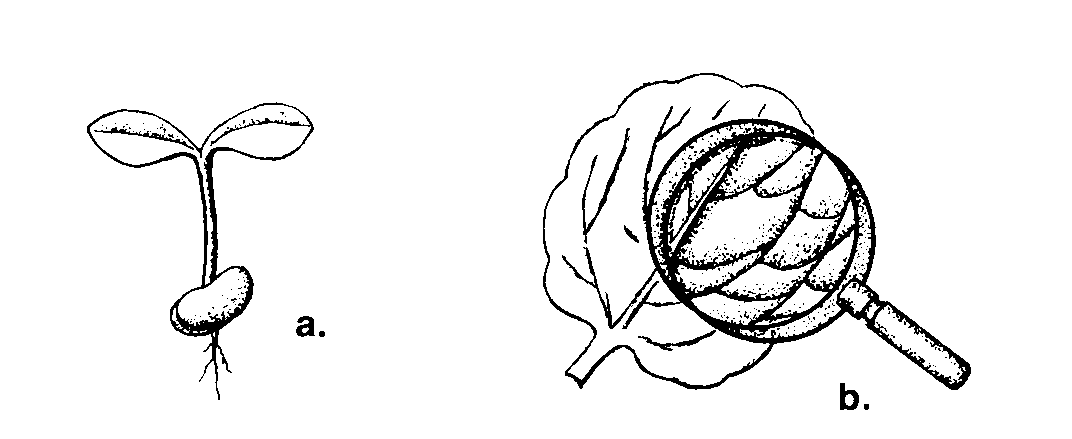
(a) Dicots (Di meaning two) emerge from the seed with two seedling leaves or cotyledons.
(b) The most distinguishing characteristics of a dicot are veins that form a net‑like pattern.

Weed Descriptions
Winter Annuals
Henbit (Lamium amplexicaule)
Other names: Dead nettle, blind nettle, bee nettle.
Growth habit: This winter annual weed grows upright and is a member of the mint family. It first appears in late winter and dominates in early spring. Henbit is very difficult to control.
Leaves: Rounded, hairy, and deeply veined leaves have coarsely toothed margins. The leaves are opposite on petioles in the lower portion of the stem. The upper leaves are attached or clasp the stem.
Stems: Several upright, green or purple, square stems are able to root and branch at the lower nodes.
Flowers: Whorls of irregular shaped flowers are found in the axils of the upper leaves. Petals are purple and fused into a trumpet shaped tube.
Seed: Nutlets are produced that contain a speckled grayish‑brown seed.
Cranesbill
(Geranium carolinianum)
Other names: Carolina geranium, cutleaf geranium.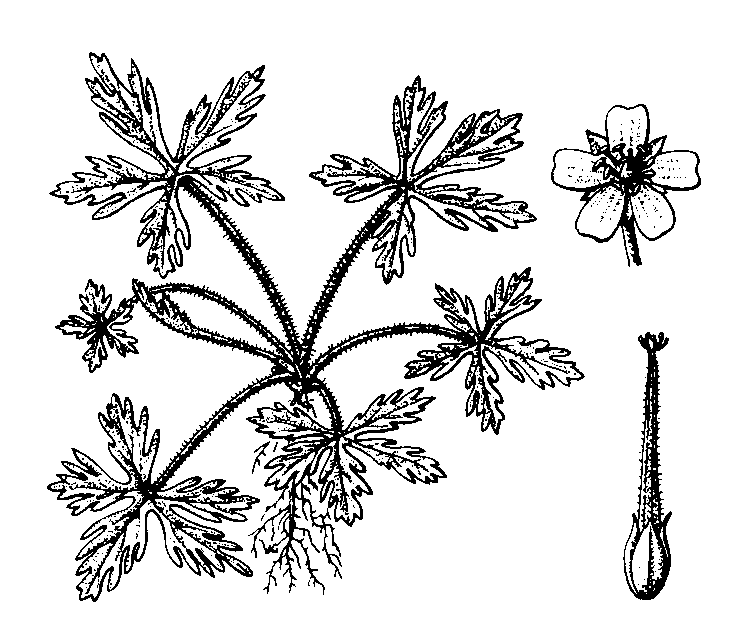
Growth habit: This freely branched annual weed remains prostrate in turf. Fine hairs are found on the stems and leaves.
Leaves: Leaves are deeply dissected into five to seven lobes. Each lobe is again lobed and bluntly toothed on the margins.
Stems: The branching stems grown along the ground and have fine hairs.
Flowers: Two to several conspicuous, small flowers are borne together on stalks from the upper nodes. It blooms mostly in April and May. Individual flowers have five pink to lavender petals.
Seed: Seeds have a conspicuous “cranesbill” beak about 1/2 inch long.
Shepherd's Purse
(Capsella bursapastoris)
Other names: Shepherd’s bag, pepper plant, case weed, pick‑purse.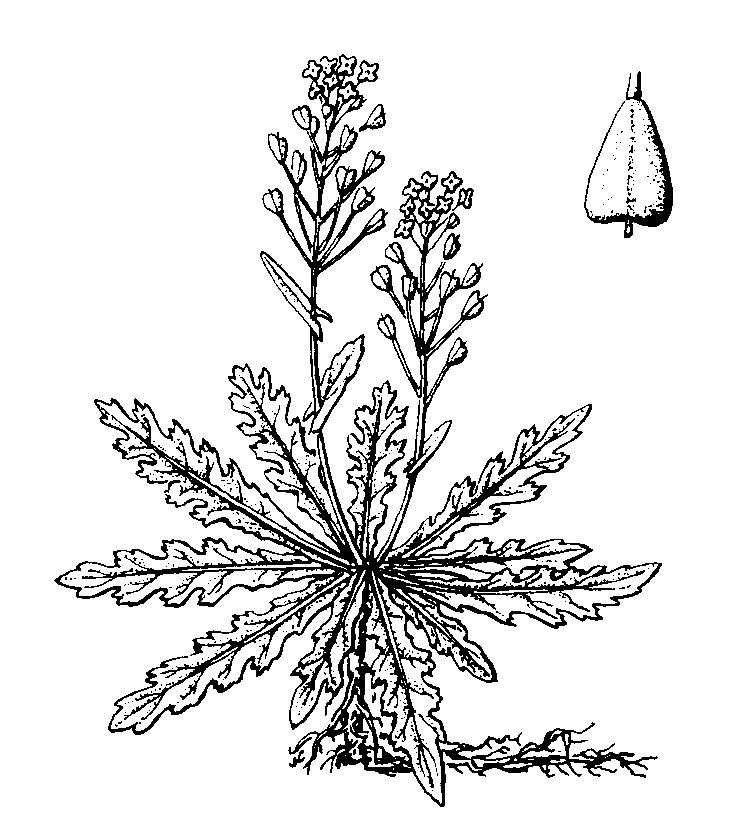
Growth habit: This annual weed is a member of the mustard family and often a problem in newly seeded areas. It grows from a rosette and forms a slender taproot.
Leaves: Alternate, narrow, toothed, or lobed leaves from a rosette appear similar to that of the dandelion. Leaves on flower stems clasp or wrap around the stem and do not have milky sap.
Stems: If it is not mowed and allowed to grow, erect stems produce arrow‑shaped leaves.
Flowers: Tiny, white flowers with four petals bloom very early in the spring.
Seed: Heart‑shaped or triangular capsules, which contain many reddish‑brown seeds, resemble purses worn by shepherds in ancient Biblical times.
Mouseear Chickenweed
(Cerastium vulgatum)
Growth habit: This perennial weed acts as a winter annual in Oklahoma and has a 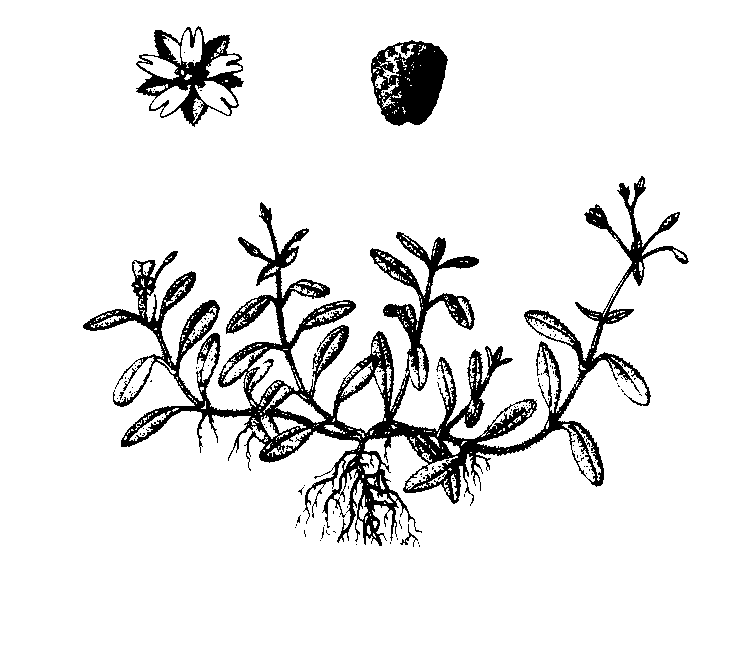 vigorous prostrate growth habit. It reproduces by seed and creeping, hairy stems that
hug the ground. Mowing only stimulates a more vigorous habit of prostrate growth.
vigorous prostrate growth habit. It reproduces by seed and creeping, hairy stems that
hug the ground. Mowing only stimulates a more vigorous habit of prostrate growth.
Leaves: Sticky, hairy leaves are opposite, oblong, dark green, and rounded on the ends.
Stems: Hairy stems may creep along the ground and take root at nodes that touch the soil.
Flowers: Small, white inconspicuous flowers have five slightly notched petals.
Seed: Small orange or brownish seed are somewhat transparent. They have rough seed coats.
Common Chickweed
(Stellaria media)
Other names: Starweed, bindweed, winterweed, satin flower, tongue grass.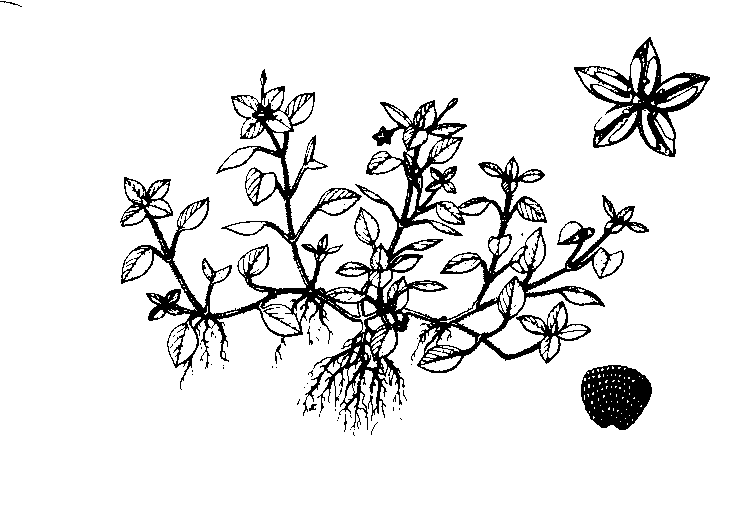
Growth habit: This low spreading winter annual has a weak and shallow root system that can cover adjacent turf and form extensive dense patches. It grows best during cool, wet weather in shady places. It rarely tolerates hot, dry conditions.
Stems: Stems are slender, branched, and have a row of fine hairs on one side. The stems creep along the ground and can root at the nodes.
Flowers: Small white flowers are borne in clusters at the end of the stems. Flowers have five deeply notched petals and, though small, are quite noticeable.
Seed: Numerous rough, dark brown seeds germinate from late fall through early spring.
Leaves: Leaves are bright shiny green, opposite, smooth, oval, and tapered to a point.
Winter Perennials
Dandelion(Taraxacum officinale)
Other names: Lions‑tooth, puffball, blowball.
Growth habit: This broadleaf weed is a very hardy perennial with a strong taproot that 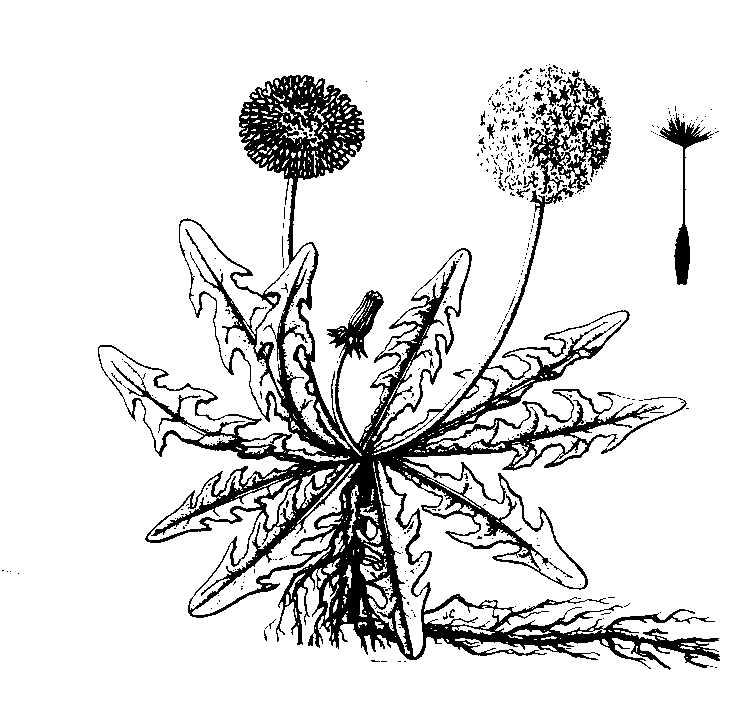 penetrates the soil 2 to 3 feet. The aboveground rosette remains the entire year.
New seedlings can appear any time during the fall or early spring.
penetrates the soil 2 to 3 feet. The aboveground rosette remains the entire year.
New seedlings can appear any time during the fall or early spring.
Leaves: Long, narrow leaves are lobed or serrated with the tips or points of these lobes usually opposite each other and pointing back toward the center of the rosette. The leaves are often purple at the base and emit a milky sap when broken.
Stems: Very short stems arise from a rosette on older plants.
Flowers: Large yellow blossoms mature into round, white puffballs full of seed. The flowers are borne on ends of hollow stalks.
Seed: The parachute‑like seeds are carried many miles by the wind. A single plant can serve as a continuous source of infestation.
Wild Carrot (Daucus carota)
Other names: Queen Anne’s lace, bird’s nest.
Growth habit: This biennial weed has a long, tough taproot. It forms a flat, branched 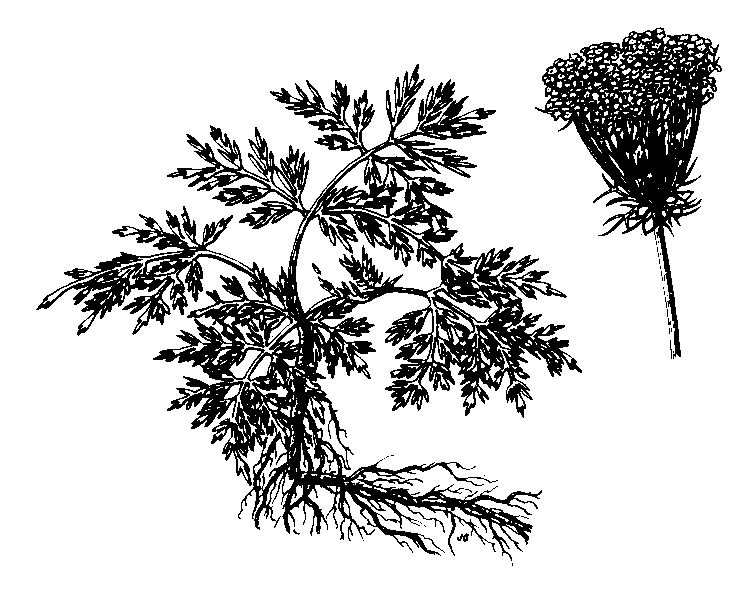 rosette of finely divided leaves that lay flat on the ground and avoid mowing.
rosette of finely divided leaves that lay flat on the ground and avoid mowing.
Leaves: Finely branched, lace‑like leaves are hairy and resemble cultivated carrot leaves.
Stems: Upright stems are produced during the second year.
Flowers: Umbrella‑like clusters of broad white flowers are borne on a slender seed stalk.
Seed: Small, concave seeds are bristly, ribbed, and measure about 1/6 inch or less in length.
White Clover (Trifolium repens)
Other names: Clover, Dutch clover.
Growth habit: This cool‑season perennial suffocates desirable grasses and goes  dormant during hot weather. The creeping stems root at the nodes and grow close to
the ground, avoiding mowing.
dormant during hot weather. The creeping stems root at the nodes and grow close to
the ground, avoiding mowing.
Leaves: Dark green leaves have three leaflets which display white crescent‑shaped marks. The trifoliate leaves have a long, erect petiole with a membranous sheath at the base.
Stems: Creeping stems that root at the nodes hug the ground and avoid mowing.
Flowers: Clusters of white blossoms with a tinge of pink are borne on long stalks. Clusters are 1/2 to 1 1/2 inches in diameter and frequently are visited by bees and other insects.
Seed: Small, heart‑shaped seeds may live in the soil 20 years or more.
Summer Annuals
Black Medic (Medicago lupulina)
Other names: Yellow trefoil, black clover, hop medic.
Growth habit: This dark green warm‑season annual grows close to the ground. It can 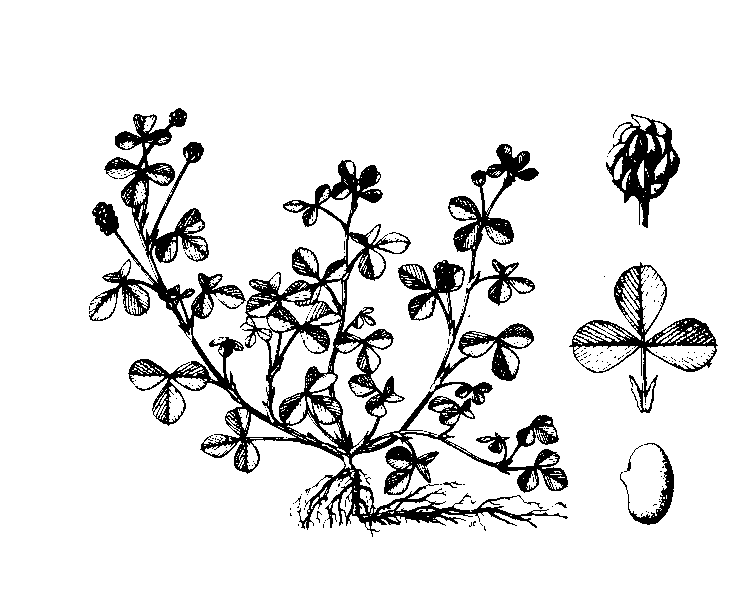 sometimes behave as a perennial during years when the winter is mild. Black medic
is a member of the legume family and has a taproot that penetrates deeply into most
soils. It often is confused with white clover, oxalis, and hop clover.
sometimes behave as a perennial during years when the winter is mild. Black medic
is a member of the legume family and has a taproot that penetrates deeply into most
soils. It often is confused with white clover, oxalis, and hop clover.
Leaves: The three‑leaflet leaves have prominent, parallel veins and are similar to most other clover leaves. The leaflets are wedged‑ shaped with a small spur or tooth at the tip. The center leaflet is on a slightly protruding or extended stem.
Stems: The spreading, prostrate stems are hairy and do not root at the nodes. Several branches grow out from the base.
Flowers: Bright yellow flowers (pea‑type) are compressed into small, dense clusters. Mature flowers form a tightly coiled, black seed pod which is strongly veined.
Seed: Each black seed pod contains a single amber‑colored seed.
Purslane (Portulaca oleracea)
Other names: common purslane, pusley, pursley, wild portulaca.
Growth habit: This warm‑season annual is very drought resistant and can become a  troublesome problem in newly established or thin lawns. The low, prostrate growth
habit forms a mat which can shade out several turfgrasses.
troublesome problem in newly established or thin lawns. The low, prostrate growth
habit forms a mat which can shade out several turfgrasses.
Leaves: The bright, shiny green, wedgeshaped leaves are thick, succulent, and often feel rubbery.
Stems: Prostrate, sprawling stems are thick, round, and reddish‑brown in color. Stems will root wherever they touch the ground, particularly if the main root has been destroyed.
Flowers: Small, yellow flowers with five petals seldom open unless the sun is shining brightly.
Seed: The cup‑shaped seed pod produces an abundance of small, dark, rounded seeds. These may lie dormant in the soil for many years.
Carpetweed (Mollugo verticillata)
Other names: Whorled chickweed, devil’s grip.
Growth habit: This slow germinating, prostrate, warm‑season annual spreads rapidly 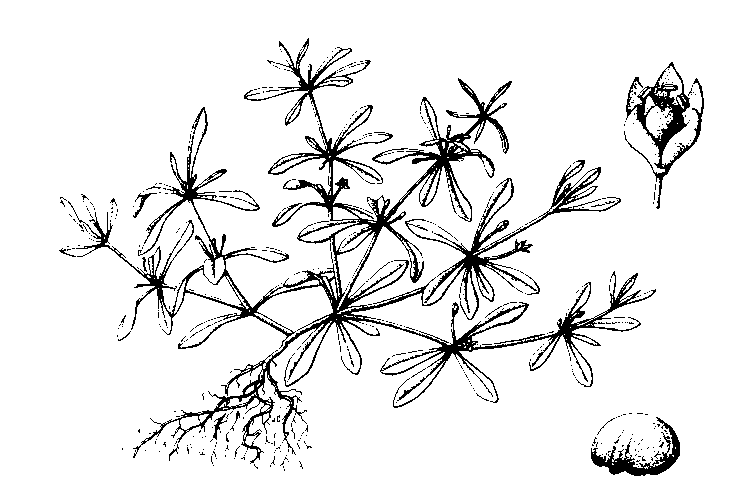 during hot weather. Carpetweed is of tropical origin, but grows vigorously in Oklahoma.
during hot weather. Carpetweed is of tropical origin, but grows vigorously in Oklahoma.
Leaves: Five to six light green, smooth, slender leaves are grouped together forming whorls at each node on the stem.
Stems: The smooth, branched stems, 4 to 6 inches long, radiate in all directions from the central taproot forming a flat circular mat on the soil’s surface.
Flowers: Several small, white flowers on short stalks arise from the nodes from May through October.
Seed: Flat, kidney‑shaped seeds are a shiny orange‑red color.
Spotted Spurge (Euphorbia maculata)
Other names: Eye‑bright, milk purslane, milk spurge.
Growth habit: This aggressive warm‑season annual grows close to the ground forming 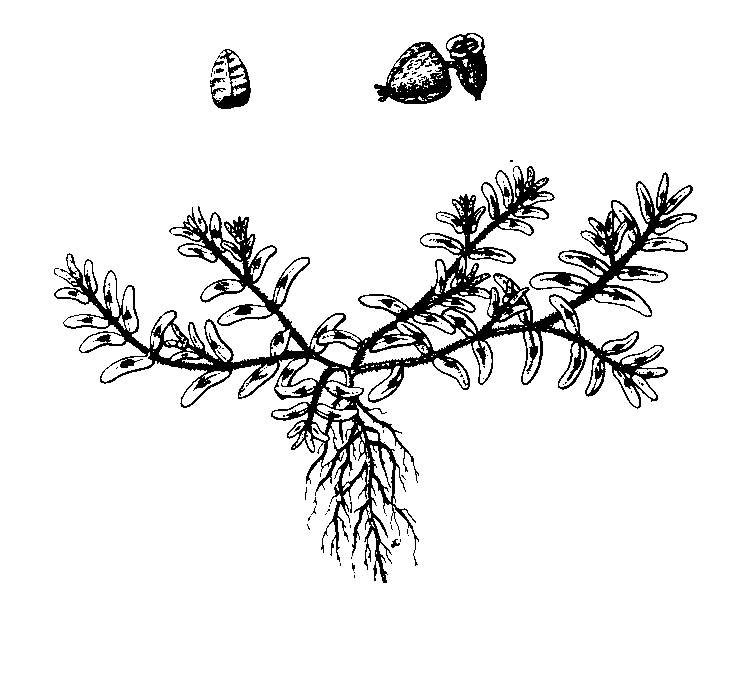 a circular mat that can eliminate desirable grasses. Few annuals produce as much seed
or grow as commonly as spotted surge .
a circular mat that can eliminate desirable grasses. Few annuals produce as much seed
or grow as commonly as spotted surge .
Leaves: Leaves vary in color from a pale reddish‑green to dark green. They usually have a maroon spot on the upper center of the leaf. The opposite and oblong leaves are smooth or sparsely hairy, toothed near the tip, and on a short petiole.
Stems: Prostrate, spreading stems branch out from a single taproot and do not root at the nodes. A milky sap is exposed when stems are broken.
Flowers: Very small, inconspicuous, pinkish-white flowers are found in the leaf axils. The fruit is a three‑lobed capsule that develops rapidly.
Seed: Seeds are oblong, three sided, and dark brown or black in color.
Prostrate Knotweed (Polygonum aviculare)
Other names: Knotgrass, cloorweed, matgrass, pinkweed, birdweed, stonegrass.
Growth habit: This warm‑season annual germinates with the first warm temperatures 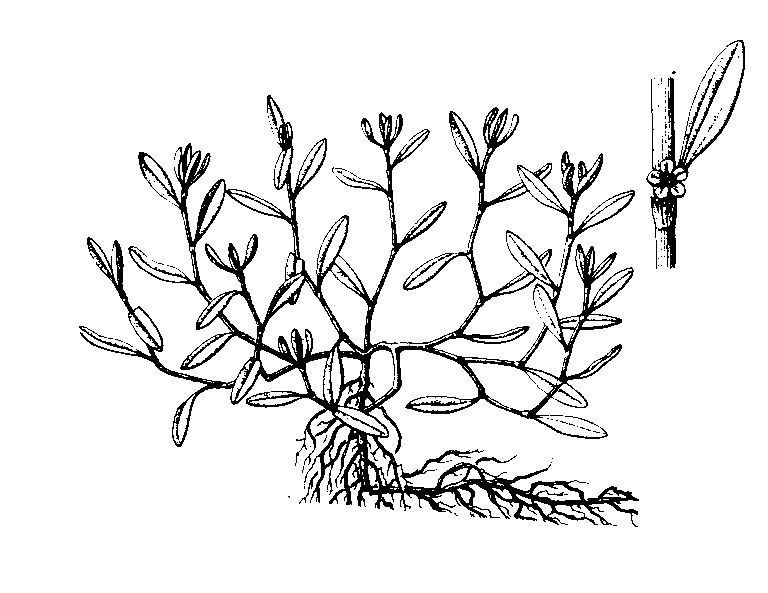 of spring. The first tiny shoots of knotweed are often mistaken for crabgrass seedlings.
It grows flat from a long white taproot forming circular mats that prevent the growth
of desirable grasses. Knotweed is well adapted to hard, compacted, worn turf areas
of high traffic. The center playing areas on football fields and areas next to driveways
and sidewalks are some problem locations where knotweed will grow.
of spring. The first tiny shoots of knotweed are often mistaken for crabgrass seedlings.
It grows flat from a long white taproot forming circular mats that prevent the growth
of desirable grasses. Knotweed is well adapted to hard, compacted, worn turf areas
of high traffic. The center playing areas on football fields and areas next to driveways
and sidewalks are some problem locations where knotweed will grow.
Leaves: Smooth, bluish‑green leaves are 1 inch long and 1/4 inch wide. They are narrow at the base with a rounded tip. At the base of each leaf there is a thin papery sheath.
Stems: Wiry, non‑rooting stems are prostrate and branch quickly forming a circular mat. Enlarged nodes give the stems a ‘knotted’ appearance.
Flowers: The tiny white flowers are very inconspicuous and are found at the junction of leaf and stem.
Seed: Seeds are small, triangular, and have a dull black color.
Summer Perennials
Curly Dock (Rumex crispus)
Other names: Sour dock, yellow dock, narrow leaved dock.
Growth habit: This perennial is normally found as a rosette in turf, but can attain a 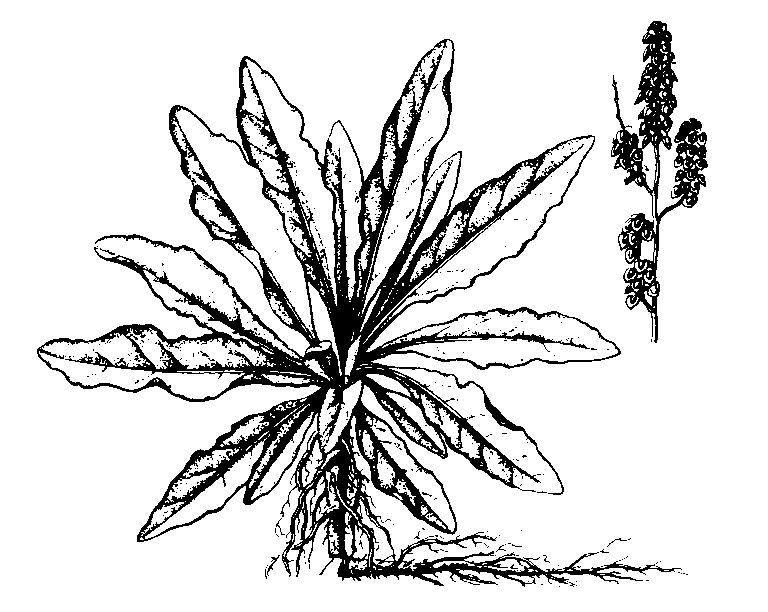 height of 2 to 3 feet. A thick brownish taproot penetrates deep into the soil. Growth
is most active when the lawn is under stress from hot, dry weather.
height of 2 to 3 feet. A thick brownish taproot penetrates deep into the soil. Growth
is most active when the lawn is under stress from hot, dry weather.
Leaves: Bright shiny green leaves appear in early spring and later become reddish‑green in color. Leaves grow mostly at the base of the plant and are lance‑shaped with wavy or curly margins. Leaf blades are 6 to 8 inches long and 1 to 2 inches wide.
Stems: Curly dock remains as a rosette in lawns and seldom produces a stem.
Flowers: This weed seldom produces flower stalks in well maintained lawns. When plants grow unchecked, small greenish flowers are produced in clusters at the top of the main stems.
Seed: Shiny, reddish‑brown, triangular seeds are contained within winged pods.
Broadleaf Plantain (Plantago major)
Other names: Door‑yard plaintain, whiteman’s foot.
Growth habit: Cool‑season perennial that forms a rosette and is found in poorly 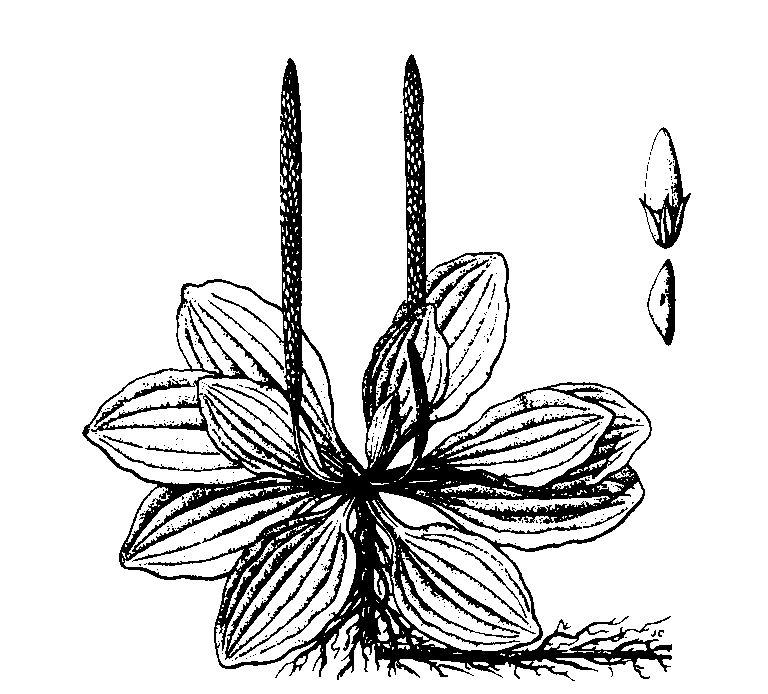 managed turfgrasses. It crowds out desirable grasses by growing close to the ground.
managed turfgrasses. It crowds out desirable grasses by growing close to the ground.
Leaves: Elliptical leaf blades are often 1 to 3 inches wide and 3 to 6 inches long. Leaf margins may be wavy with five prominent veins. The leaves are covered with short hairs that make it rough to the touch.
Flowers: Conspicuous flower stalks 3 to 6 inches long are shorter than buckhorn (P.lanceolata) and flowers are arranged along more than half of the stem.
Seed: The seeds are brown to dull red and irregularly angled with small lines that run their entire length.
Buckhorn Plantain (Plantago lanceolata)
Other names: English plantain, narrowleaved plantain, rig‑grass, ribwort, black‑jacks.
Growth habit: Widespread perennial broadleaf in poor lawns. Taproot has strong lateral 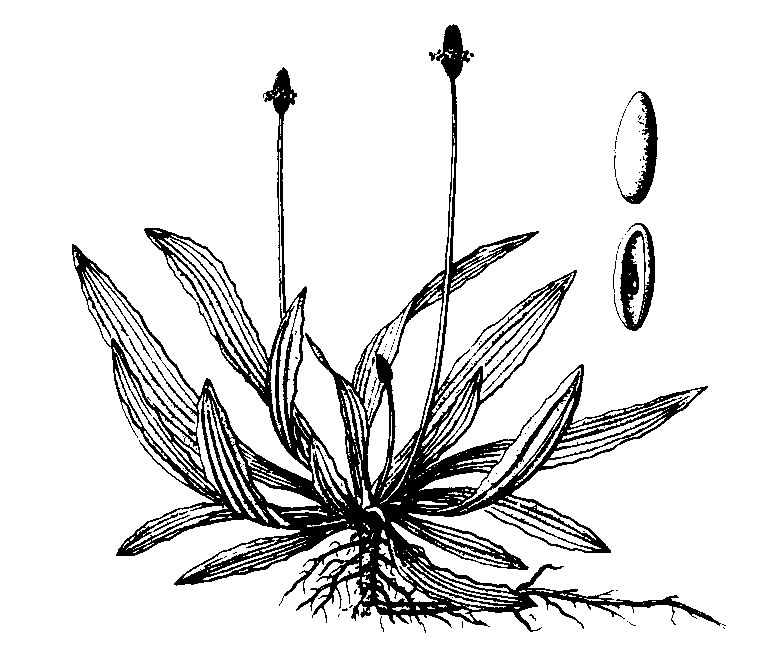 roots from which a rosette of leaves arises. Cutting or pulling only results in a
new plant springing from any part of the severed root.
roots from which a rosette of leaves arises. Cutting or pulling only results in a
new plant springing from any part of the severed root.
Leaves: Long, narrow leaves with three to five parallel veins are 3 to 12 inches long. Brownish hairs surround the base of leaves which often twist and curl.
Flowers: A tall, hairy stalk terminates in a cluster of flowers in a tightly compressed cylinder. Several crops of seed are produced during the season.
Seed: Smooth, shiny seeds are oblong and greenish‑brown in color.
Common Yarrow (Achillea millefolium)
Other names: Milfoil, thousand‑leaf, bloodwort.
Growth habit: These hairy perennial plants with spreading rootstocks may grow 1 to 2 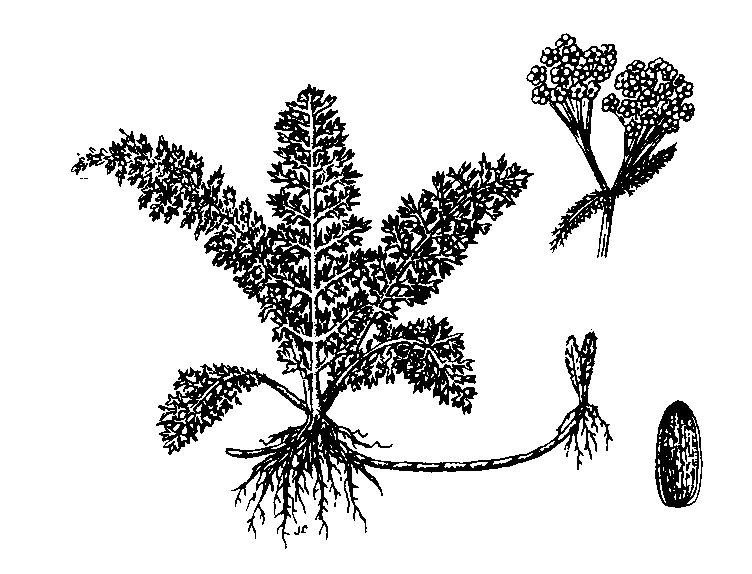 feet tall. The entire plant is strongly scented. It produces strong rhizomes which
make this weed very aggressive in turf. Yarrow forms dense patches, hugging the ground
to avoid mowing.
feet tall. The entire plant is strongly scented. It produces strong rhizomes which
make this weed very aggressive in turf. Yarrow forms dense patches, hugging the ground
to avoid mowing.
Leaves: Alternating leaves are somewhat like the soft, finely divided, fern‑like leaves of cultivated carrots.
Stems: Covered with grayish‑green, fine hairs, the stems are erect and sometimes branched.
Flowers: Flowers have white or light yellow petals with pale yellow centers and form dense, flat clusters at ends of stems. Flowers are not normally found in turf.
Seed: White to gray, flat, oblong seeds are slightly over 1/16 inch long and have lines which run along the entire length.
Herbicides
The most commonly used herbicides for controlling broadleaf weeds are 2,4‑D, Banvel (dicamba), MCPP (mecoprop), and 2,4‑DP or DPC (Dichloprop). These post-emergence herbicides selectively control most winter and summer broadleaf weeds in turf. To increase the different kinds of weeds they control, many broadleaf weed killers are a mixture of these herbicides. These herbicides are safe on established bermudagrass, Kentucky bluegrass, tall fescue, perennial ryegrass, and zoysiagrass.
Three related chemicals are 2,4‑D,MCPP, and DPC.They are relatively immobile in the soil and pose little threat to nearby trees and shrubs from root absorption. Most chemical residue in soil is dissipated in three to four weeks. However, shrubs, trees, and vegetables can be damaged by drifting vapors or spray. Use caution when spraying them around susceptible plants and choose a time when the wind is minimal (less than 5 mph).
Banvel (dicamba) is commonly added to broadleaf weed herbicides to control tough weeds, such as henbit and knotweed. Banvel is mobile in the soil and can be absorbed by roots of ornamentals and trees, which may lead to their injury or death. Therefore, never apply Banvel or broadleaf weed herbicides containing Banvel within the drip line of trees and other ornamentals.
The amine salt formulations of these herbicides are safest around susceptible plants during hot weather. Low volatile esters can be used during the early spring and late fall when the highest day temperature does not exceed 60° to 70 F. Try not to apply any of these herbicides when the air temperature exceeds 85 F or is so low (i.e., less than 50 F) as to prevent active weed growth. These herbicides are not safe on newly established turf when applied at the recommended rate for established turf areas.
Herbicide Application Timing
Effective weed control with 2,4‑D, Banvel, MCPP, and DPC combinations usually involves more than one application. Two to four applications, spaced 10 to 14 days apart, may be necessary for satisfactory results. The best time to control winter broadleaf weeds is in the fall during October and November. The plants are smaller at this time and lower rates will provide control. The next best times are during the late winter and early spring, however higher rates will be needed.
Summer broadleaf weed problems are effectively controlled during the spring of each year (April and May). As the weed becomes more mature, the higher recommended rates and number of applications will be required to effectively control the weed. Always remember, small actively growing weeds are easier to control than mature weeds that are starting to produce seed.
Original material prepared by Michael P. Kenna.
Illustrations by Jim Converse, The 0. M. Scott & Sons Company.
Extension Consumer Horticulturist
